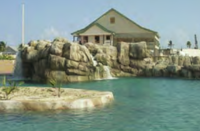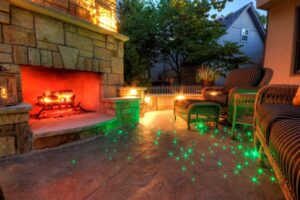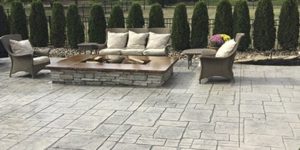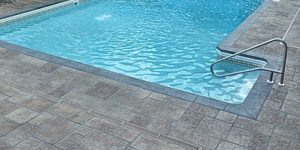
From a family of contractors Joe Fettig’s career in concrete has been all about new challenges. That’s what drew him to decorative concrete after getting a start in flatwork.
Joe Fettig is a concrete contractor who wants to keep them happy. He wants to see them impressed… excited… awed… and fired up about decorative concrete. And that’s just his hopes for his crew.
His drive for customer satisfaction is even stronger. But for Fettig, who operates JAF-Co Concrete Inc. in and around Portland, Ore., you can’t get there without the employees. He pays competitive wages and takes advantage of the industry’s training networks to keep his workers engaged.
“We find it is rewarding to see them smile and go home happy at the end of the day,” Fettig says. “As long as there are opportunities to be challenged, and they can improve their lifestyles, that to me is what makes a successful company.”
The company includes Fettig and his wife Betsy, who runs the company’s design center in Newberg, Ore., as well as eight full-time workers in the field and an office manager. Fettig runs two crews: one that installs flatwork and one consisting of decorative specialists. All of his workers started as flatwork specialists and then cross-trained into decorative areas.
JAF-Co’s decorative division does premium work on upscale properties, which is not unusual for a decorative concrete company. What is unusual about this one is that it operates at this market altitude without specializing in specific applications.
 “That’s the thing that makes our company unique,” Fettig says. The company offers stamping, acid staining, overlays, microtoppings, countertops or most anything else a customer needs.
“That’s the thing that makes our company unique,” Fettig says. The company offers stamping, acid staining, overlays, microtoppings, countertops or most anything else a customer needs.
Fettig is aware of the oft-heard philosophy in the industry, “stick with what you know.” He agrees. Jaf-Co can offer such a wide range of service because of the investment in employee training and R&D, he says.
“We have some very self-driven people, so they’re eager to learn any new challenge put up in front of them.”
Oregon to Vegas and back again
Fettig’s career in concrete has been all about new challenges. That’s what drew him to decorative concrete after getting a start in flatwork.
A native of Oregon, he grew up in a family of contractors. With uncles in concrete construction, he gained experience at an early age. In 1985 he set out on his own for the boomtown of Las Vegas, where he worked for a variety of contractors on everything from residential pools to casino jobs.
“The decorative concrete industry was starting to take off at that time and I watched the stamping systems evolve from the old cast aluminum cookie cutter stamps to the textured mat stamps,” Fettig says. “This was really sparking my attention.”
Up until then, he had been using early techniques such as broom finishes on colored concrete. The salt finish was also a popular application, as well as Kool Deck toppings placed over concrete pool decks. “But the textured mat stamp was a tool we could use with limitless possibilities,” Fettig recalls.
That’s when he got the buzz for decorative concrete. “One of the biggest draws to decorative concrete was the reaction we would get from people looking at our work,” he says. “People were convinced that what they were seeing was not concrete.”
In 1993, Fettig decided it was time for another career move. He returned to Oregon, this time with a family, and started his own company. JAF-Co (the J-A-F are his initials) started as a flatwork company. Fettig’s timing was right again, as a Northwest housing boom was building for a blastoff.
 The company established itself with residential construction. But Fettig remained interested in the decorative work he’d done in Las Vegas and he began to expand his services a little at a time. Then, six years ago, he told his crew that it was time to make a leap. Their knees rattled a little, but nobody hesitated at the ledge.
The company established itself with residential construction. But Fettig remained interested in the decorative work he’d done in Las Vegas and he began to expand his services a little at a time. Then, six years ago, he told his crew that it was time to make a leap. Their knees rattled a little, but nobody hesitated at the ledge.
“One of the biggest challenges we faced in making the step from doing residential flatwork to starting the decorative side of our company was stepping out of our comfort zone,” Fettig says.
“As we started our journey into the decorative concrete marketplace we found ourselves searching for solutions to problem products. Once you have put the miles into installing different product lines, you learn real fast which products you want to work with and which ones to run from. We’ve found that the sooner you get involved with the product training seminars and start building good relationships with your local reps, the journey becomes a walk that you enjoy taking everyday.”
Some might find the move from the desert air of Las Vegas to the less cooperative climate of Oregon an operational challenge. But having grown up in the rainy state, he takes its climate for granted.
Compared to Oregon, planning and scheduling was a breeze in Las Vegas, he says, but added that “around here you just apply the old rule: If it’s gonna rain, don’t pour.”
 Other than that, during the mild local winters, he uses hot water and non-chloride accelerators, and drops the slump a little. “It’s not rocket science once you learn the trade,” he says, adding that like anything else with a concrete business, it comes down to having a good relationship with a ready-mix supplier.
Other than that, during the mild local winters, he uses hot water and non-chloride accelerators, and drops the slump a little. “It’s not rocket science once you learn the trade,” he says, adding that like anything else with a concrete business, it comes down to having a good relationship with a ready-mix supplier.
Getting the word out
The Northwest climate does lead to a different marketing strategy: Push the interior work in the winter months. Another marketing push for Fettig is annual maintenance. Every contractor should be selling annual reseal from the get-go, he says. Not because maintenance generates significant revenue, but because every contractor should think of his completed jobs as marketing. If existing decorative concrete goes neglected and looks poor, it’s just bad advertising for everybody.
Fettig finds that his best advertising is word-of-mouth. After that, it’s JAF-Co’s design center, 1,200 square feet of interior displays and 3,000 square feet of exterior applications. This was a major step for the company, and a big capital investment, but it has paid rewards, Fettig says. The company’s new Web site is designed to work in concert with the design center.
The interior display is essentially a high-end home, featuring microtop floors, acid-stain countertops, a bar, and fireplace surround. The exterior display is a patchwork assortment of color, pattern, and texture techniques.
The design center works, Fettig says, because words and pictures are not enough. People simply need to see, to touch. “You can take your shoes off and walk across the floor.”
Indeed, the company’s signature work is becoming the sand etch finish, popular on stairs and walks, which feels like sand under bare feet.
When customers tour the center, Fettig still gets the same buzz that he did in the early days in Las Vegas. “To this day we have folks walk into our design center and they are amazed that what they are looking at is a concrete product,” he says.
“I guess the thrill that draws me to decorative concrete is to be able to take thoughts and ideas from our clients and present them with an overall design and a finished product that leaves them smiling for years to come.”
And, he says, he and his crew enjoy the fact that each new job turns out to be the new favorite, which he attributes to the wide-open possibilities of decorative concrete.
“Every job we do, we advance in. That’s what turns our gears about this,” he says.
www.jafco-concrete.com





























